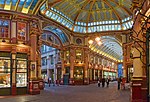Lloyd's of London, generally known simply as Lloyd's, is an insurance and reinsurance market located in London, United Kingdom. Unlike most of its competitors in the industry, it is not an insurance company; rather, Lloyd's is a corporate body governed by the Lloyd's Act 1871 and subsequent Acts of Parliament. It operates as a partially-mutualised marketplace within which multiple financial backers, grouped in syndicates, come together to pool and spread risk. These underwriters, or "members", are a collection of both corporations and private individuals, the latter being traditionally known as "Names".
The business underwritten at Lloyd's is predominantly general insurance and reinsurance, although a small number of syndicates write term life assurance. The market has its roots in marine insurance and was founded by Edward Lloyd at his coffee house on Tower Street in c. 1686. Today, it has a dedicated building on Lime Street within which business is transacted at each syndicate's "box" in the underwriting "Room", with the insurance policy documentation being known traditionally as a "slip".The market's motto is Fidentia, Latin for "confidence", and it is closely associated with the Latin phrase uberrima fides, or "utmost good faith", representing the relationship between underwriters and brokers.Having survived multiple scandals and significant challenges through the second half of the 20th century, most notably the asbestosis affair, Lloyd's today promotes its strong financial "chain of security" available to promptly pay all valid claims. As of 2019 this chain consisted of £52.8 billion of syndicate-level assets, £27.6bn of members' "funds at Lloyd's" and over £4.4bn in a third mutual link which includes the Central Fund.In 2020 there were 76 syndicates managed by 50 managing agencies that collectively wrote £35.5bn of gross premiums on risks placed by 350 brokers. Of those premiums 53 per cent emanated from North America, 27 per cent from Europe and 20 per cent from the rest of the world. Direct insurance represented 65 per cent of the premiums, mostly covering property and casualty (liability), while the remaining 35 per cent was reinsurance.











